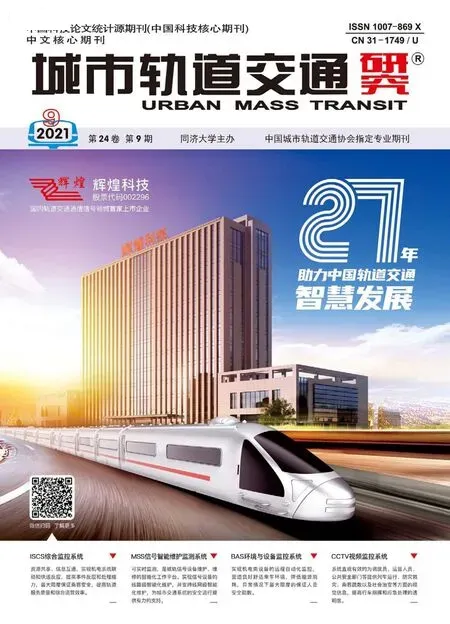市域軌道交通地下敷設方式的不利影響亟待引起重視
顧保南 葉霞飛
(同濟大學交通運輸工程學院教授、博士生導師)

Adverse Impacts of Suburban Line Underground Laying Method Appeal for Imperative Concerns
GU Baonan,YE Xiafei
(Professor, PhD Supervisor of College of Transportation Engineering, Tongji University)
The construction of Shanghai Airport Link Line and Jiamin Line in recent years marks the establishment of Shanghai urban rail transit line network. According to public documents, the proportion of underground laying method in domestic urban rail transit lines is growing. For example: Shanghai Airport Link Line mainline has whole length of 68.6 km, of which 56.7 km are underground, equaling to 82.6%; Jiamin Line mainline has whole length of 44.04 km, of which 41.36 km are underground, equaling to 93.9%. These two suburban lines are located in suburban areas outside the Shanghai Outer Ring Expressway, and the density of existing buildings along the lines are low. While their functionality resembles suburban rail transit lines of Tokyo Metro, it is mostly above-ground laying method (elevated or ground surface) in Tokyo Metro, and underground section takes less than 10%. The significant difference in laying method choice between the two Shanghai suburban lines and Tokyo Metro lines appeals for reflection.
Compared with above-ground laying method, the major merits of underground laying method lie in less noise and adverse impact on landscape. However, underground laying method brings about other adverse impacts such as increased construction and operation cost, limited transportation efficacy and improvement, and risk of uncertainty in transport capacity responding to future passenger flow volume:
1) Significant increase in line construction cost. For a common rail transit line, construction of underground line costs higher than that of elevated line. For example, comparing Shanghai Rail Transit Line 2 (underground) with Line 3 (elevated), the total engineering investment of per unit length increases by 58%. Currently, for middle stations without overtaking functionality, the engineering investment difference between underground station and elevated one is 150 million yuan per station. If the station is set up with overtaking functionality, the difference can escalate to 600~700 million yuan per station. Since suburban line requires multiple middle stations to be set up for overtaking, to adopt underground laying method will drastically surge the engineering investment.
2) Evident increase of line operation cost. The increased operation cost of underground line compared with above-ground one lies in maintenance and upgrading of lighting power consumption and other equipment. In the same comparison, the lighting power consumption of Shanghai Rail Transit Line 2 and Line 3 in 2006 are 2 916 000 kWh/km and 933 000 kWh/km respectively. Evidently, the power consumption of underground line increases by 212% compared with above-ground one.
3) Limited traveling speed improvement. Generally, routes adopting underground laying method don′t set up for overtaking line. Under line condition of station interval of 4~6 km and highest operating speed of 120~160 km/h, by excluding overtaking design and stopping at each station, line traveling speed can only reach 60~65 km/h. If above-ground laying method is adopted, most of the stations can be set up for overtaking, where flexible operation organization schemes of express/local trains are allowed and can boost traveling speed to great extent.
4) Inflated timespan for commuters along the line lowers passenger flow attraction. For routes excluding overtaking choice, extension of station interval is generally adopted to increase traveling speed, but it will also increase the timespan for passengers who need to shuttle between starting point home (or office) and station. The increased timespan of shuttling will inflate the total timespan of the traveling chain, lowering its attraction towards passenger flow.
5) Limited transport capacity improvement. Under the condition of same operating interval, the transport capacity is associated with train length. Once the underground station completes construction, effective length of the station platform can′t be extended, potentially risking whether the future passenger flow demand can be met. While above-ground station only requires small amount of investment to reserve certain space at both ends of the station to allow extension of station platform effective length when line is operational, improving transport capacity according to passenger flow demand.
Although many more merits exist in elevated or ground surface laying method compared with underground one, it is merely adopted in the current domestic urban rail transit line construction practice. The main reason is the noise and adverse impact on landscape inevitably caused by elevated or ground surface lines. As a matter of fact, effective measures conquering noise and adverse impact on landscape have been acquired impressively. For example:
1) For undeveloped areas along the line, station-city integrated design can lower these adverse impacts to an acceptable degree. Shanghai Rail Transit Line 11 exemplifies with applying elevated format in the majority of Jiading district.
2) For developed areas along the line, noise can be controlled within allowable range according to indicators in regulation through vibration and noise reduction technology. The ‘fully closed noise barrier’ of Beijing-Xiong′an Intercity Railway has provided an outstanding demonstration that noise can be controlled within allowable range of indicators at the speed of 350 km/h. Comparatively speaking, when urban rail transit is at speed lower than 200 km/h, the noise can be easily managed.
3) In terms of planning, trunk road network planning of the whole urban area should be developed. Newly added radial and circumferential trunk roads should be considered to set up in accordance with line shape standards of urban rail transit elevated line, and construction of noise-sensitive buildings along it should be restricted. When the urban rail transit line network must densify in the future, there can be more available choices for elevated rail transit path so that the overall urban rail transit construction performs substantially.
To encapsulate, the construction of urban rail transit is a centennial plan that necessitates comprehensive apprehension of laying method choice significance, and thorough reasoning of merits and harms so that the laying method is adopted wisely, nurturing high-quality development of rail transit suburban line construction and operation.
(TranslatedbyZHANGLiman)

